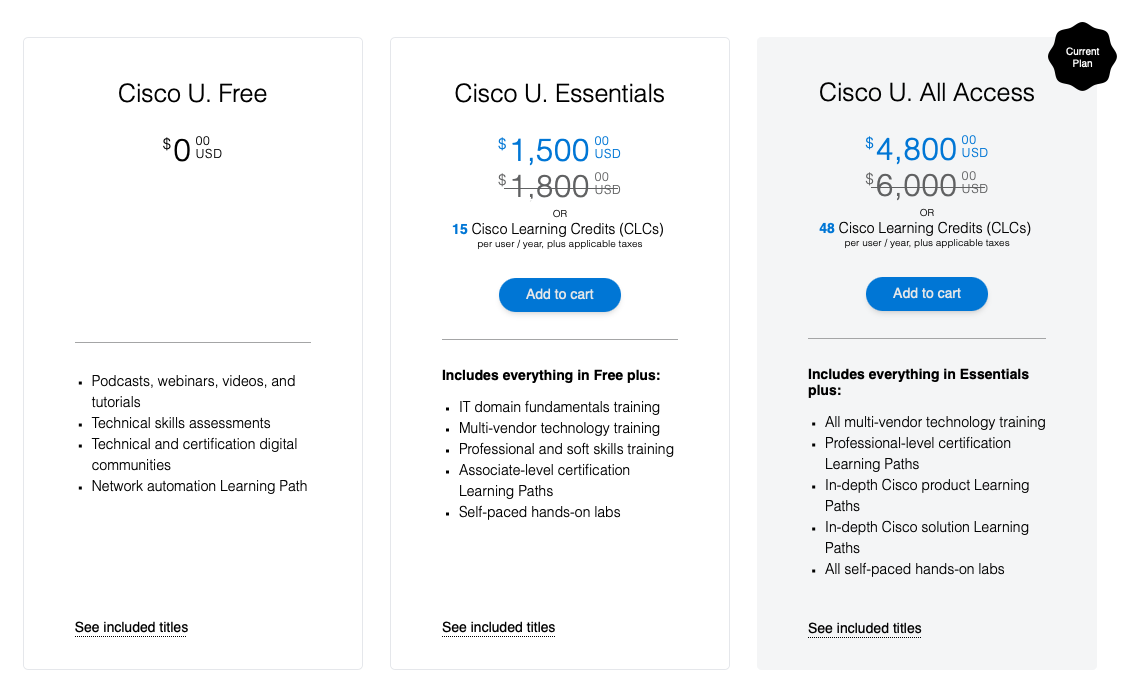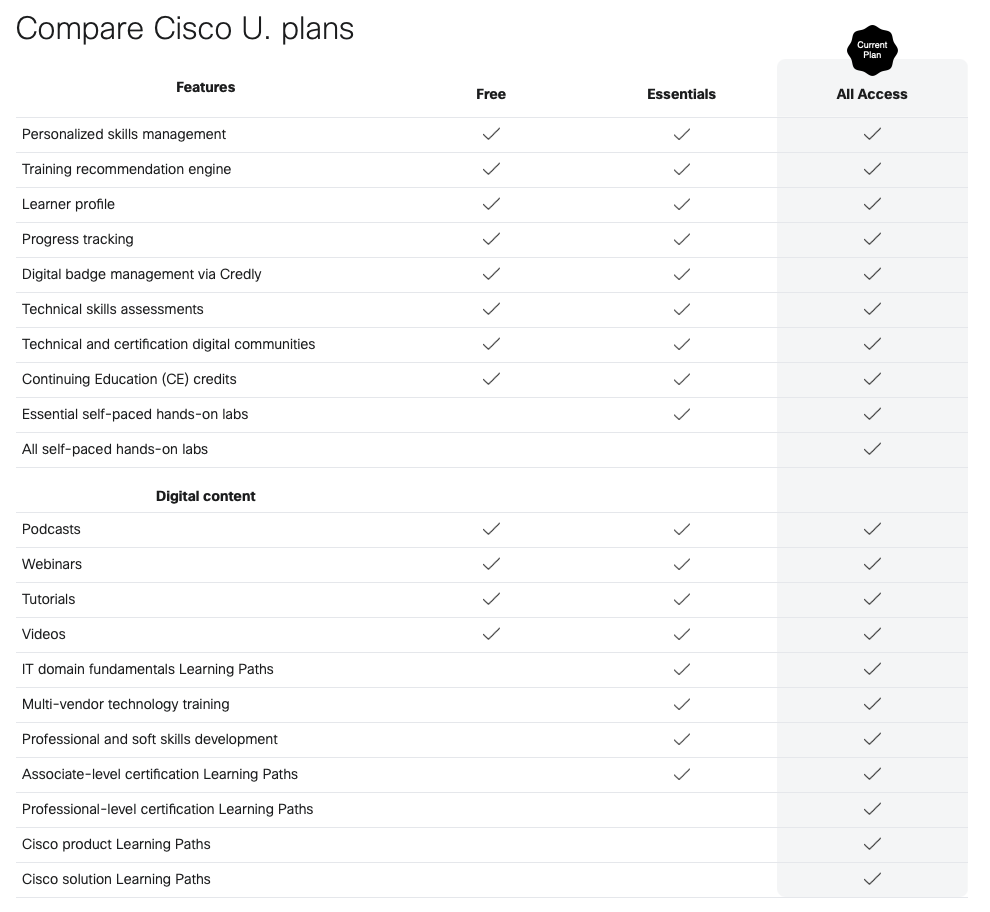Cisco U. - A short review
Earlier this week it was announced that Cisco U. is now available to everyone. There was an early access phase from last year on. I was lucky to get an early access and I was able to test Cisco U. for some time. At the Cisco Learning & Certification booth at Cisco Live 2023 in Las Vegas back in June last year there was also the opportunity to do some beta testing with the Cisco U. user interface. Now it is available for everyone for free until July 29, 2023. During that time there are special introductory pricing for your subscription after the free trial period. I encourage everyone who have not tried to use the time wisely to decide if there is a subscription plan for you and which one is right for you. But let’s check what is available there.
Subscription plans
The three different subscription plans Free, Essentials, and All Access and they are obviously slightly different. All Access is pretty clear, it gives you access to the full feature set and all digital content available. A price of $6,000 ($4,800 with current discount) or 48 Cisco Learning Credits (CLCs) seems a proud price. The Essentials plan takes only one feature away which is the All self-paced hands-on labs and but keeps the Essential self-paced hands-on labs feature which could be good enough for many students.

Depending on your knowledge level, learning and certification goals the major drawback will be the missing Professional-level certification Learning Paths content within the Essentials subscription. More or less important in this context could also be the removed Cisco product Learning Paths and Cisco solution Learning Paths. In my opinion the Essentials subscription looks good and with a regular price of $1,800 ($1,500 with current discount) per year seems to be a fair price considering the amount of content you get. You could also use 15 Cisco Learning Credits (CLCs) to purchase it.
The Free plan consists the same features from the Essentials except the Essential self-paced hands-on labs and the digital content is limited to Podcasts, Webinars, Tutorials, and Videos. The missing opportunity to do self-paced labs could be a exclusion criterion, but one key point about the Free plan is the opportunity to earn Continuing Education (CE) credits from the content provided. Today it is really important to stay relevant in the industry and maintain your Cisco certifications.

I saw some critical discussions on Social Media about the prices of the subscriptions plans which I can understand to a certain point. The All Access plan seems too expensive for individuals in particular for young people or juniors who are at the beginning of their career. But the price is doable for companies supporting their employees. As I already wrote before, the Essentials plan has a fair price and I think investing $125-150 a month in yourself should be possible. It is an invest in yourself and your career. Many people often forget what an amount of work is behind providing high quality learning and training content. Preparing content with examples, building labs, and recording videos is a time consuming thing. Everyone who has ever prepared a training session knows how much time and work you need to put in to create good content which brings a value to the attendees. The Cisco Learning & Certification team did a really good job with Cisco U. providing high quality courses, learning paths, or self-paced hands-on labs.
Room for improvements
However there is always room for improvements, especially the user interface could be improved while you are in a course. Forward and backward navigation through the sections and subsections of a course and returning back to the course overview seems to me not quite intuitive. After spending some time with a course it’s getting better because I have arranged with the navigation. The courses itself I was going through were a mixture between pre- and post-assessment questions, videos, reading, and hands-on labs which is a pretty good combination to learn in general. The pre-assessment tests at each section will check your knowledge about the contents. Based on your results Cisco U. recommends which sections you could skip because you have proficient knowledge and which sections you should work on. At the end of each subsection there are also some content review questions. The self-paced hands-on labs provide a virtual lab environment similar from the Cisco Learning Network Store courses including an introduction video and detailed step-by-step guidance through the the lab. After each main section there is a post-assessment to verify your knowledge again providing a score report of the subsections. I am not 100% sure if the pre- and post-assessments contain the same questions but it seems so. I would like to have the option to mark questions during the assessments for later review. The detailed score reports gives a good understanding of what you need to study more and which domain but there is no option to review the single questions.
Conclusion
Cisco U. provides high quality learning content and brings a lot of value to the students in my opinion. The courses vary from technology categories like Software Networking, Security, Cloud and Computing, Security, Data Center, Mobility and Wireless, and others. Besides courses for Cisco certifications and products there are also Microsoft, AWS, and vendor independent trainings. The close linking to the Cisco Learning Network community is another great benefit to stay in contact with study peers. The opportunity to ask for help, share your knowledge and experience from courses, labs or learning paths, and help others when running into problems, shows again that learning is easier with a collaborative community. I hope you like my quick review post about Cisco U. and please leave a comment if you like. Thank you for reading!
Comments
Post comment